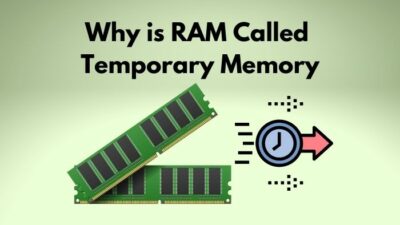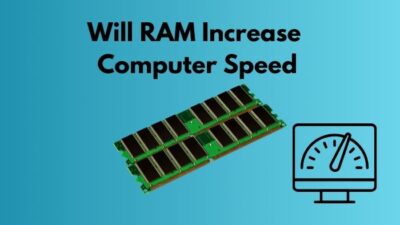When shopping for a memory kit for your PC, you’ve surely seen the CAS latency or CL timings listed in the specifications, like CL17-18-18-39 or just CL17. Heck, many retailers even mention the memory kit’s CL in the product name.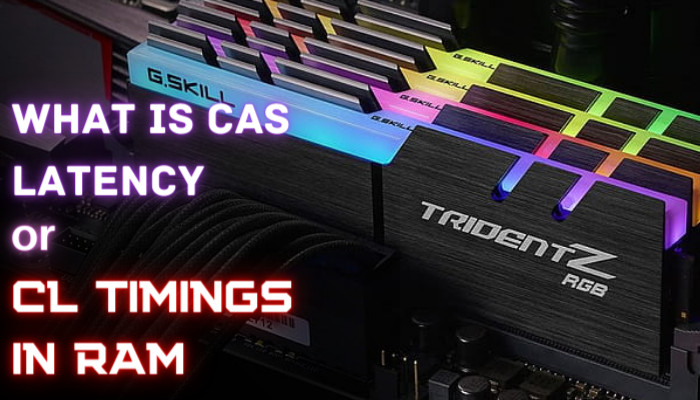
So what does this CL or CAS Latency mean, and is it just as or more important than the memory speed/frequency?
Let’s find out.
What is CAS Latency(CL)?
CAS Latency, CL for short, stands for Column Access Strobe Latency which can also be described as memory latency. It refers to the time a DRAM module takes to access a set of data from one of its columns & make it available in its output pin, starting from when the READ command was sent from the memory controller.
In simple words, CAS latency is the delay time/number of clock cycles between the READ command and the time when the data gets available.
Let me make it more understandable; a RAM kit with 17 CAS latency takes 17 clock cycles to output a set of data called by the CPU.
The CAS latency of a memory kit can be described in various ways. For example, a DRAM module with 17 CAS latency can be referred to as CAS 17, CL17, or C17 by the vendors. It can also be listed in memory timings like CL17-18-18-38. In this case, the number after CL is the CAS Latency.
This latency is measured in nanoseconds for asynchronous DRAM and clock cycles for synchronous DRAM.
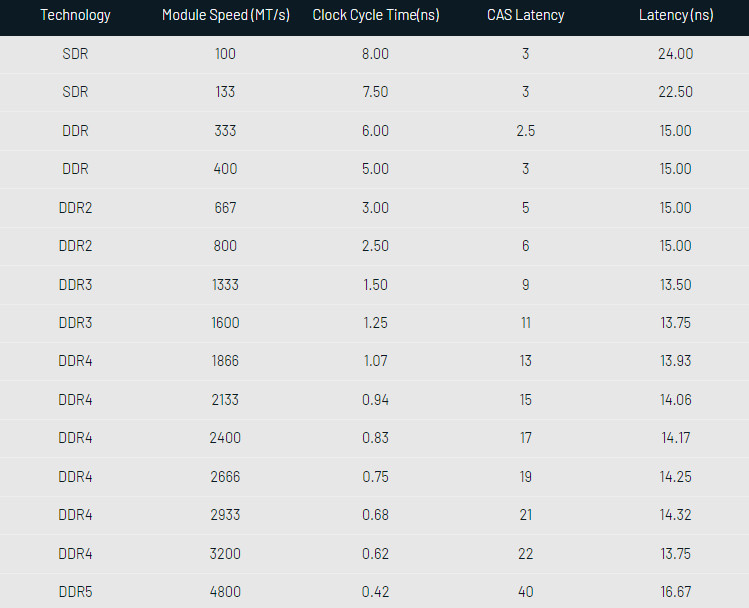
Besides CAS latency, there are three other types of primary memory latency. These four latency types are called primary timings: tCL/tCAS(Column Access Strobe Latency), tRCD(Row Address to Column Address Delay), tRP(Row Precharge Time), and tRAS(Row Active Time).
These latency types are the numbers that we can see after CL in memory timings. Here’s what each number of the memory timings indicates: 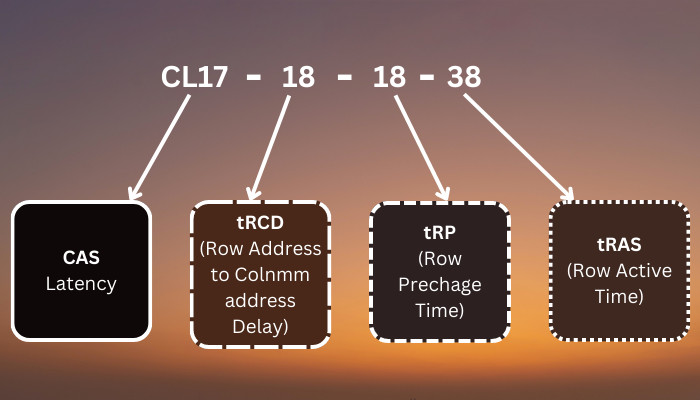
FYI, you should know how RAM and CPU work together to get a better understanding of this whole process.
How to Check CAS Latency
When you buy a memory kit, the CL is usually mentioned on the box or in the website listing. So you can check the CAS latency of those RAM kits from there before buying. But to check the CAS latency of an installed memory stick, using a third-party app is the most viable option.
You can check the CAS latency of your computer’s DRAM module(s) by using a reliable third-party software called CPU-Z. Here’s how:
- Download the CPU-Z setup file from the CPU-ID website and install it.
- Launch the CPU-Z app and click Yes if you get prompted with User Access Control. You can also download the portable version in ZIP. In that case, extract the ZIP file and launch the cpuz_x64 file.
- Head over to the Memory tab. In the Timings section, you’ll see the operating CAS latency of your computer’s memory modules.
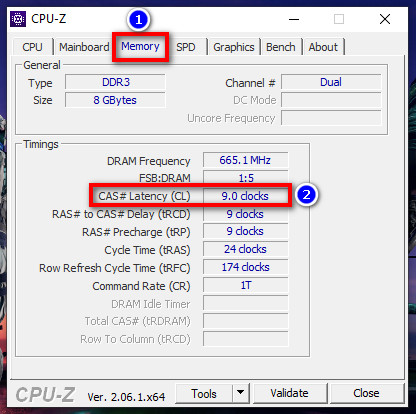
- Go to the SPD tab if your PC has more than one stick of RAM. Here, you’ll be able to see the definite CAS latency of a specific RAM stick.
- Click on the drop-down for the Memory Slot Section to choose which memory stick’s CAS latency you want to see.
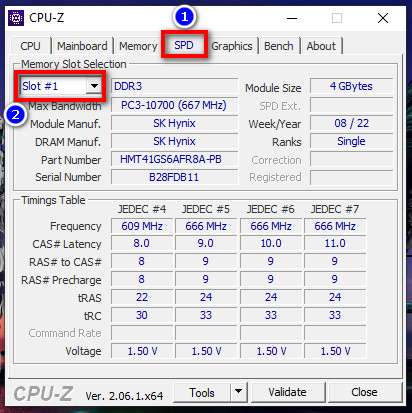
You can also check the other primary timings as well as additional useful information about your DRAM modules via CPU-Z. These information can come in handy if you want to increase the RAM speed.
Memory Speed vs. CAS Latency: What’s the Difference?
Memory speed or RAM frequency is the data transfer rate of the memory kit. It’s the amount of time a DRAM takes between receiving an operation request from the CPU and reading/writing the requested set of data.
In a nutshell, memory speed refers to how fast the memory controller can read/write or transfer data, and memory latency refers to how quickly this operation can start.
RAM speed is measured in MT/s or mega transfer per second, while memory or CAS latency is measured in ns(nanoseconds). Some vendors might also show the memory speed in clock rate rather than transfer rate, like 3600MHz rather than listing as 3600MT/s.
If you want to know more, here’s our in-depth guide on MHz vs MT/s.
How Does Different CL & Memory Speed Translate in Real-World Performance?
Now that you know what CAS latency means, you might wonder how CAS latency translates into real-world performance. Although CAS latency is an important aspect, it’s not the definitive performance indicator.
In the case of memory latency, you can’t just rely on CAS latency and make a judgment about which memory kit will perform better. You need to consider both memory speed and CAS latency to determine the performance of a DRAM module. Here’s a simplified breakdown:
The memory latency(measured in nanoseconds) is the combination of the memory clock cycle and CAS latency. A 16GB CL17 DDR4-2400 kit’s memory latency is 14.17ns(0.83 clock cycle × 17 CL), and a 16GB CL19 DDR4-2666 kit’s memory latency is 14.25ns(0.75 clock cycle × 19 CL).
Since both kits have similar memory latency, the DDR4-2400 memory kit with CL17 will perform slower than the DDR4-2666 memory kit with CL19 due to higher memory speed(2400MT/s vs 2666MT/s).
On the other hand, if both memory kits had the same memory speed, the one with the lower CAS latency would provide faster operation than the one with a higher CAS latency.
Furthermore, not every application scenario would show better performance due to lower CAS latency. For example, a CL15 DDR4-3600 and a CL19 DDR4-3600 modules have an actual memory latency of 8.33ns and 10.56ns respectively.
So you might not see any performance difference in day-to-day tasks, but you may notice some performance gain in high-end games with the CL15 kit.
Which One to Pick: High-Speed RAM or Low Latency RAM?
To be honest, there’s no clear-cut answer to whether memory speed is more important or CAS latency. It depends on a case-by-case basis. But in most cases, a faster DRAM will provide better performance than a slower memory module.
While scrubbing through my Premier Pro 8K video timeline, I saw a noticeably smoother performance on my CL20 DD4-4000 memory kit compared to my previous CL15 DDR4-3200 one.
But for simple tasks like browsing the web or playing light indie games, you might not notice any difference at all, no matter which one you choose.
When you’re shopping for a memory kit, first identify the highest supported memory speed by your computer’s CPU and motherboard. Then look for which memory kit has lower latency at that memory speed and pick one according to your budget.
On a side note, check out our guide on which memory slot to use to ensure the best PC performance.
Why Does DDR5 Have Higher CAS Latency than DDR4?
You might have noticed that the latest DDR5 modules come with a noticeably higher CAS latency than the DDR4 kits. To be honest, it’s nothing new. Previously, DDR3 kits also had lower CL numbers than DDR4.
So why do newer, better memory modules have higher CAS latency, and does it affect performance?
Well, as we’ve discussed earlier, memory speed and memory latency are more important than CAS latency. Furthermore, the difference in CL numbers comes down to how they are calculated.
For example, CAS latency=Memory latency(ns)÷Clock Cycle Time(ns). So, the CAS latency for a DDR5-4800 kit is 16.67ns÷0.42ns=40ns. Meanwhile, a DDR4-2933 kit’s CAS latency is 14.32ns÷0.68ns=21ns.
As you can see, despite having very little difference in memory latency(16.67 vs 14.32), the gap between the two memory kits’ CAS latency is almost double(CL40 vs CL21).
So don’t worry about the higher CAS latency of DDR5 compared to DDR4. A CL40 DDR5-6000 memory kit will blow a CL17 DDR4-3600 DRAM kit out of the water in real-world performance.
Here’s our detailed comparison between DDR4 and DDR5 memory modules.
Frequently Asked Questions
Is higher CAS latency better?
No. Higher CAS latency means a longer delay in DRAM operation, which can slow down your PC.
What is a good CAS latency?
For DDR5 memory kits, C32 to C36 is an ideal range for CAS latency. On the other hand, C15 to C17 is considered good CAS latency for DDR4 modules.
Can I mix DRAM modules with different latencies on my PC?
Yes, you can mix DRAM modules with different latencies, but I’d advise not to do so. Even in the best-case scenario, you’d be running the memory modules at the slower memory’s timings.
To Sum It Up
- CAS latency, or Column Address Strobe latency, is the delay time between the moment a memory controller requests data from a memory module and when the data is available to be read.
- Lower CAS latency generally means faster memory performance, provided that the memory frequency, latency, and capacity are the same between the comparing memory kits.
- A DDR5 memory module will have better performance than a DDR4 memory kit despite having higher CAS latency.

